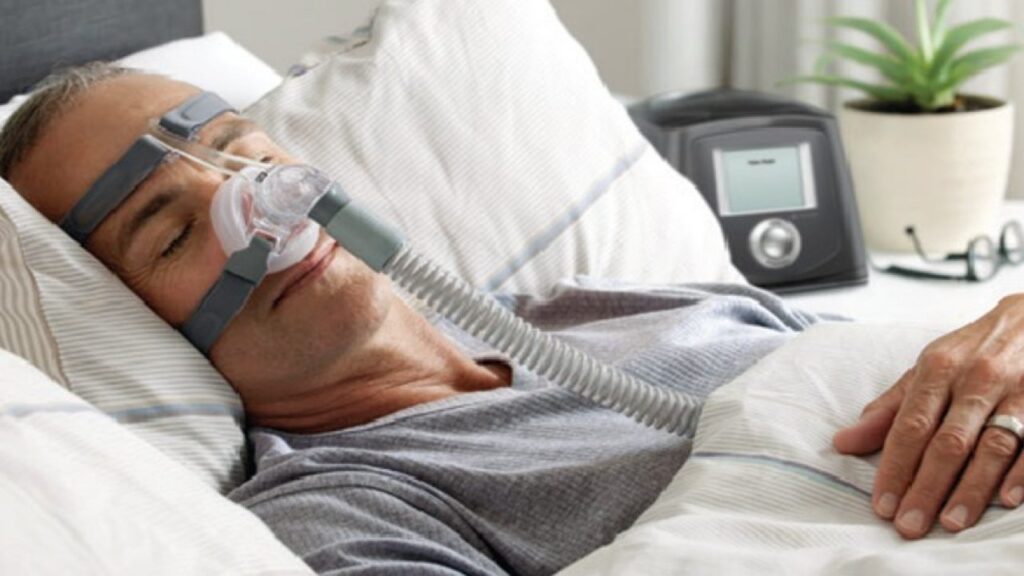Everyone who has used a continuous positive airway pressure (CPAP) machine knows how frustrating mask leaks can be: whistling sounds, dry eyes, and even the risk of an accident.
To effectively treat sleep apnea, a CPAP machine must provide adequate air pressure to prevent airway collapse; any leaks in this airflow impair the efficacy of the treatment. If the air leak is big enough, the patient’s airway may partially or completely collapse again.
Tips on how to find the best mask fit for your particular CPAP mask can be obtained from your Air Liquide Healthcare Sleep Specialist.
In addition, that air doesn’t simply vanish. When a CPAP user’s mask has a leak, air might escape and cause irritation by blowing in their eyes, making a hissing noise, or drying out their mouth and throat. Some of the most common reasons CPAP users stop using the device are the aforementioned side effects, which may seem inconsequential in contrast.
Fortunately, locating and fixing most leaks is a simple process. Learn about the most common reasons for cpap mask leaks and how to fix them here.
See Also: Analyzing the Adverse Effects of a Typical CPAP Mask

How to Prevent CPAP Mask Leaks and Their Causes
- You have the wrong fit for your CPAP headgear.
Many CPAP mask cushions create a seal by inflating; thus, it may seem counterintuitive that tightening the straps too much could cause a leak. If the mask is too snug, the cushion won’t be able to fully inflate and form a seal.
However, air can get through if the headwear is excessively big and baggy. After activating the ventilation system, your headwear should fit snugly without leaving any gaps, but not so tightly that it hurts.
The Solution: While in your normal sleeping position, try moving your headpiece about. When you’re lying down, your face takes on a different form than when you’re sitting or standing.
- You’ve Got the Incorrect Size CPAP Frame or Cushion
Despite how obvious it seems; CPAP users frequently wind up with the incorrect size mask. Because there is no universal standard for mask sizes between manufacturers, and because most measurement guides fail to specify the part of the face from which the mask should be sized, this is the case.
This is especially the case if you go out and buy a new mask without first getting it professionally fitted.
How It Works: Our state-of-the-art AI technology detects your anatomical features and suggests the best mask for you. Simply get the app and snap a selfie to get started. Fill out our brief qualification form, and a Sleep Specialist from Air Liquide Healthcare will be in touch.
If you’d rather not use technology, your Specialist can also provide you with a printable sizing guide that is tailored to your mask. Furthermore, they will instruct you on how to measure yourself for a CPAP mask, giving you the assurance that you have made the best possible decision.

- Your CPAP Machine Is Outdated
Your CPAP mask will eventually wear out from regular use. After some time, the padding will become ineffective. Micro-tears appear in silicone over time. The same goes for your headgear and body. All of these things have the potential to disrupt the mask’s seal and let air escape.
The Solution: Every 2 weeks to 3 months, you should swap out your CPAP cushion or nasal cushions, and every 6 months, you should switch out your mask frame and headgear.
- Your CPAP Pillow Cover Needs to Be Cleaned
The cushion of your mask might become clogged with debris, oils, and dead skin if you don’t clean it regularly. This buildup is not only a breeding habitat for germs and bacteria, but it may also break down the silicone and cause cracks and splits.
Solution: After each use, wipe clean your mask with a moist cloth or CPAP wipe and wash it weekly in warm, soapy water.
Mask liners are an alternative to the suggested cleaning schedule in case real life gets in the way. Liners for masks lay between the cushion and your face, collecting oils and sweat to keep your mask clean and provide a better seal.
- Your Sleep Mask Doesn’t Fit Your Personality
It’s important to find a mask that works with your unique sleeping posture and breathing pattern. If you sleep on your side, a full-face mask could not form a tight enough seal to be effective. However, if that side sleeper also breathes through their lips, using a nasal mask could cause them to experience mouth leak. If you choose a CPAP mask that doesn’t go with your lifestyle, you’re less likely to use it consistently.

The Solution: Attempt an Alternate Mask or Mask Design.
A nasal mask or nasal pillow mask is typically prefered by side sleepers, stomach sleepers, and active sleepers. Their low profile and reduced padding could allow for more mobility.
However, a full-face CPAP mask is recommended for people who breathe through their mouths. Or, a chinstrap can be used to avoid mouth leak when wearing a nasal or nasal pillow mask by people who like to breathe through their mouths.
Learn more about the best types of CPAP masks from your Sleep Specialist or do some research on the topic on your own.
Avoid Waking Up Due to a Leaky CPAP Mask
The single most crucial aspect of your sleep therapy is to stick with it. Do not delay in contacting Air Liquide Healthcare Sleep if you have already attempted to fix your mask leak and are still experiencing difficulties. If you’re having trouble getting a good night’s sleep, your personal Sleep Specialist will help you find a solution.
More to read: Position-Specific Considerations When Choosing a CPAP Mask

